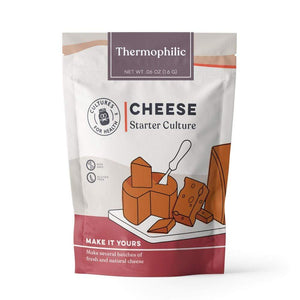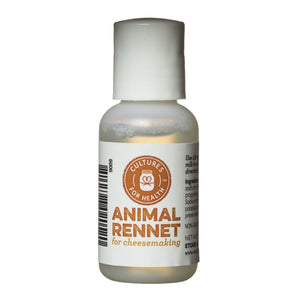
Romano cheese, like parmesan, is known for its sharp flavor. It can be shredded or grated and added as a garnish to soups, pizza, pasta, and more.
10 minutes
3 hours
1 Block
INGREDIENTS AND EQUIPMENT AVAILABLE AT CULTURES FOR HEALTH
Thermophilic Starter Culture

Thermophilic Starter Culture
$19.99
This useful culture makes a variety of hard cheeses, including parmesan, romano, provolone, and swiss.
Mild Lipase Powder
Liquid Animal Rennet

Liquid Animal Rennet
$12.99
High quality single strength animal rennet. This non-GMO animal rennet is preferred for aged cheese as it creates a more desirable flavor and aroma during the aging process. Each bottle contains enough rennet to set (12) 2-gallon batches of cheese.
Cheese Salt

INGREDIENTS:
- 2 gallons skim milk
- 3/4 cup heavy cream
- 1 packet direct-set thermophilic starter
- 1/4 tsp. lipase powder, dissolved in 1/4 cup cool water
- 1/2 tsp. liquid rennet , diluted in 1/4 cup cool water
- Cheese salt (about 2 Lbs.) for brine
- 1 to 2 Tbsp. olive oil
INSTRUCTIONS:
- Bring the milk temperature up to 88°F over medium-low heat. Stir in the heavy cream as it is heating.
- Once temperature has been reached, add the starter and the lipase. Stir in gently with your cheese spoon using up-and-down motions for one full minute. Cover the milk and allow it to ripen for 10 minutes, undisturbed.
- Stir in the diluted rennet for several minutes using up-and-down motions, then cover the milk and allow it to set undisturbed at 88°F until the curd gives a clean break.
- Cut the curd into 1/4-inch cubes with your curd knife.
- Heat the cut curds to 116°F over the span of 45 minutes, bringing the temperature up by only 2°F every 5 minutes. Maintain 116°F for 30 minutes, or until the curds become quite firm. Drain off the whey at this point.
- Line a 2 Lbs. cheese mold with clean, damp cheesecloth. Scoop the curds into the mold and press at 5 pounds of pressure for 15 minutes.
- Remove the cheese from the mold and remove the cheesecloth. Flip the cheese over and re-dress it in the cheesecloth. Place the cheese back into the mold and re-apply the pressure at 10 pounds for 30 minutes.
- Remove, undress, flip, and re-dress the cheese. Place it back into the mold and press at 20 pounds of pressure for 2 hours.
- Repeat the flipping procedure, and replace the pressure at 40 pounds of pressure for 12 hours. Make a saturated brine (32 ounces of salt in 1 gallon of water) and chill it.
- Remove the cheese from the mold. Peel away the cheesecloth and place the cheese into a large non-reactive bowl. Pour in the brine and allow the cheese to soak for 12 hours in the bowl of brine, covered and set into the refrigerator.
- Take the cheese out of the brine and pat it dry with paper towels.
- Air-dry the cheese on a rack in a place away from drafts and direct sunlight for 5 to 6 hours, or until the rind isn’t damp.
- Age the cheese in a ripening box or cellar at 55°F for a minimum of 2 months. (85% humidity is optimum.) Flip repeatedly during the aging period. After 2 months, rub the rind of the cheese gently with olive oil to prevent excess drying and cracking.
The cheese can be aged for 5 to 12 months longer.
















